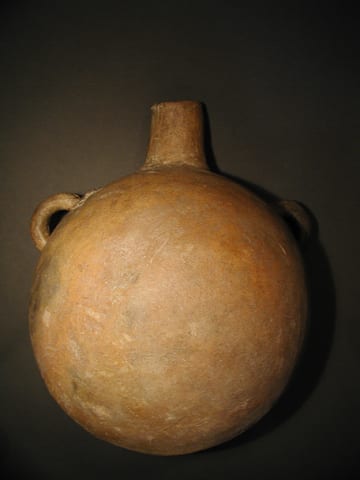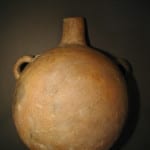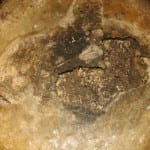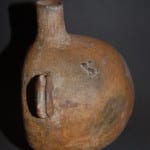Utility canteen (late 19th century?) These sorts of canteens, a posole cooking pot (1998-05) and a piki bowl (2010-17 and 1993-05) were the basic cookware in a Hopi kitchen. As is often the case with a wide flat surface, the flat side of this canteen cracked on firing and was sealed by being covered in pinion pitch, remnants of which remain.
This canteen was surly not made by Nampeyo, but for a 1901 picture of her showing how such canteens were carried by women to obtain water from the springs below First Mesa, see Kramer (1996:26, fig. 5). For pictures of Nampeyo in her home with similar canteens, see Kramer (1996:72 and 75) and Nampeyo photographs on file. See also, the Blairs (1999:140) for a 1906 group of such canteens. James (1956:photograph p. 5 following p. 110) shows an old Hopi woman carrying a canteen up the trail to second mesa villages. A similar postcard photo is on file.
The process of constructing large water hauling canteens like 1998-01 is described in great detail by Alexander Stephen in his Journal. Using a flat stone or level sand as a support, the flat back is first formed by using coils of clay to form a flat spiral that is then smoothed out. Then coils of clay are added around the edge until the sides are built up a bit higher than where the neck and handles will be affixed. A cylinder of clay is then used to form the spout. A ring of clay encircles the cylinder spout on the inside and is smoothed out to form a sort of gasket; two inches or more of the clay cylinder inside the jar are then pressed down over the sealed junction with the body to make the clay homogeneous. Two holes are then punched in the clay where a handle is to be affixed. Coils of clay are inserted from the outside to form the handles and, as with the spout, a gasket of clay is placed at the juncture of the handle and the inside walls and pressed to seal the juncture. The extra clay from the handle is then smoothed down over the gasket, leaving the portion of the canteen surrounding the handles on the inside a bit thicker than elsewhere. The remaining walls of the canteen are then built up to form the completed “belly” of the jar (Stephen 1936 and 1969:1188-1189).
During the semi-annual Snake Dance, such water canteens were used to contain the snakes before they were danced (See Steven, 1936 and 1969:730-731). I saw this canteen and three others at W.E. Channing & Co., Santa Fe during the summer of 1997 and contacted them six months later for the purchase. Channing had purchased the canteens from another Santa Fe dealer several years earlier, but no provenance was available.





